Propagation Channel Characterization for 6–14 GHz Bands Based on Large Array Measurement for Indoor Scenarios
Abstract
:1. Introduction
- A systematic measurement in the indoor scenario is conducted with bandwidth of 8 GHz from 6 GHz to 14 GHz.
- Analyses of channel characteristics are conducted with respect to varying bandwidth and carrier frequency. Statistical models were proposed to describe the changes of the channel characteristics.
- In spatial domain, the variations of the wideband channel are observed with regards to different receiving antenna elements and MU locations.
- The sparsity of the channel is discussed by analyzing the DoF in frequency domain.
2. Measurement Configurations
2.1. Indoor Measurement Environment
2.2. Measurement Equipment and Setup
2.3. Measurement Data Description
3. Analysis of Characteristics for Wideband Channels in 4 Dimensions
3.1. Effect of Carrier Frequency on Channel Characteristics
3.1.1. Sparsity Analysis via PDP and FDoF
3.1.2. Frequency Selective Fading Analysis via RMS Delay Spread
3.1.3. Channel Fading Characteristic Analysis via K-Factor
3.2. Effect of Bandwidth on Channel Characteristics
3.2.1. Sparsity Analysis via FDoF
3.2.2. Frequency Selective Fading Analysis via RMS Delay Spread
3.2.3. Channel Fading Characteristic Analysis via K-Factor
3.3. Channel Characteristics Variation with regards to Antenna Elements
3.3.1. Frequency Selective Fading Analysis via RMS Delay Spread
- In general, the changes of RMS delay spread are more significant in the perspective of carrier frequency than antenna elements. As explained above, the high carrier frequency causes high path loss and decreases RMS delay spread.
- With specified carrier frequency, the values of RMS delay spreads in antenna rows are larger than that in antenna columns. The interpretation can be derived accroding to the spatial power distribution in Figure 3b: the larger values in Figure 11a reflect the severe power changes in a row, while the smaller values in Figure 11b show the minor changes in a column.
- The variations of RMS delay spreads in antenna rows are more severe than that in antenna columns. This observation reveals the rich scattering effect in the environment, especially in terms of antanna rows. Mapping to the measurement environment, the scatterers are vertically stratified in the classroom with similar scatterer distributions at the same height. In different rows, the different scatterer distributions lead to different channel fadings, which is reflected in the severe variation of RMS delay spread, which is the opposite in different columns.
- For quantitative analysis, the total size of the virtual antenna array is around [cm]. However, in such a small space, the RMS delay spread changes from [s] to [s] in a certain carrier frequency band. Thus, the environment has a great influence on the wideband channel.
3.3.2. Channel Fading Characteristic Analysis via K-Factor
- Opposite to RMS delay spread, the K-Factor is larger in higher frequency band. With great attenuation, the number and power of NLoS paths are decreased more critically compared to LoS paths. Therefore, the K-Factor increase with increasing carrier frequency.
- Figure 12b shows a trend that K-Factor increases greatly in large columns. The reason for this could be similar in Section 3.1.3 that the pilaster near Position 1 is on the left, which brings more MPCs in small columns, causing the dominance of NLoS paths.
3.4. Impact of User Locations on Channel Characteristics
- The similar distributions of the power are observed in Figure 3 with small lags in delay.
- The sparsity of the channel in frequency and spatial domains with different user locations is introduced in Figure 13. As location changes, the DoF in these two dimensions changes with a similar increasing trend in the long term, both showing that the channel is more sparse when closing to Position 1 with less MPCs.
4. Statistic Channel Models
4.1. Conventional Delay Spread Channel Model
4.2. ARIMA Delay Spread Model
5. Conclusions
- In the carrier frequency domain, because of the severe path loss in high-frequency band, decreasing power leads to poor performance of the channel.
- Wide band brings more DoFs to the channel, increasing the rich scattering effects and influencing the time dispersion effect.
- From the perspective of different antenna elements, the wideband channel is stochastic with significant changes along the antenna rows, which is reflected in the environment. Moreover, in future work, research on channel performance in complicated environment with large antenna array needs to be considered, as it is influenced by the aperture of the large antenna array greatly in space.
- With different user locations, the characteristics are almost the same with slight differences because of the distribution of MPCs caused by the neighboring environment.
Author Contributions
Funding
Data Availability Statement
Conflicts of Interest
References
- FCC. New Public Safety Applications and Broadband Internet Access Among Uses Envisioned by FCC Authorization of Ultra-Wideband Technology; Federal Communications Commission: Washington, DC, USA, 2002. [Google Scholar]
- Yang, L.; Giannakis, G. Ultra-wideband communications: An idea whose time has come. IEEE Signal Process. Mag. 2004, 21, 26–54. [Google Scholar] [CrossRef]
- Bas, C.U.; Ergen, S.C. Ultra-wideband Channel Model for Intra-vehicular Wireless Sensor Networks Beneath the Chassis: From Statistical Model to Simulations. IEEE Trans. Veh. Technol. 2013, 62, 14–25. [Google Scholar] [CrossRef] [Green Version]
- Cassioli, D.; Win, M.; Molisch, A. The ultra-wide bandwidth indoor channel: From statistical model to simulations. IEEE J. Sel. Areas Commun. 2002, 20, 1247–1257. [Google Scholar] [CrossRef] [Green Version]
- Molisch, A. Ultrawideband propagation channels-theory, measurement, and modeling. IEEE Trans. Veh. Technol. 2005, 54, 1528–1545. [Google Scholar] [CrossRef]
- Keignart, J.; Daniele, N. Subnanosecond UWB channel sounding in frequency and temporal domain. In Proceedings of the 2002 IEEE Conference on Ultra Wideband Systems and Technologies (IEEE Cat. No.02EX580), Baltimore, MD, USA, 21–23 May 2002; pp. 25–30. [Google Scholar]
- Ghassemzadeh, S.; Jana, R.; Rice, C.; Turin, W.; Tarokh, V. Measurement and modeling of an ultra-wide bandwidth indoor channel. IEEE Trans. Commun. 2004, 52, 1786–1796. [Google Scholar] [CrossRef]
- Molisch, A.; Foerster, J.; Pendergrass, M. Channel models for ultrawideband personal area networks. IEEE Wirel. Commun. 2003, 10, 14–21. [Google Scholar] [CrossRef]
- Venkatesh, S.; Ibrahim, J.; Mckinstry, D.R.; Buehrer, R.M. A spatio-temporal channel model for ultra-wideband indoor NLOS communications. IEEE Trans. Commun. 2009, 57, 3552–3555. [Google Scholar] [CrossRef]
- Rappaport, T.S.; Xing, Y.; Kanhere, O.; Ju, S.; Madanayake, A.; Mandal, S.; Alkhateeb, A.; Trichopoulos, G.C. Wireless Communications and Applications Above 100 GHz: Opportunities and Challenges for 6G and Beyond. IEEE Access 2019, 7, 78729–78757. [Google Scholar] [CrossRef]
- Abbasi, N.A.; Gomez-Ponce, J.; Shaikbepari, S.M.; Rao, S.; Kondaveti, R.; Abu-Surra, S.; Xu, G.; Zhang, C.; Molisch, A.F. Ultra-Wideband Double Directional Channel Measurements for THz Communications in Urban Environments. In Proceedings of the ICC 2021—IEEE International Conference on Communications, Montreal, QC, Canada, 14–23 June 2021; pp. 1–6. [Google Scholar] [CrossRef]
- Maccartney, G.R.; Rappaport, T.S.; Sun, S.; Deng, S. Indoor Office Wideband Millimeter-Wave Propagation Measurements and Channel Models at 28 and 73 GHz for Ultra-Dense 5G Wireless Networks. IEEE Access 2015, 3, 2388–2424. [Google Scholar] [CrossRef]
- Sangodoyin, S.; Molisch, A.F. A Measurement-Based Model of BMI Impact on UWB Multi-Antenna PAN and B2B Channels. IEEE Trans. Commun. 2018, 66, 6494–6510. [Google Scholar] [CrossRef]
- Adeogun, R. On Propagation Graph Model for Industrial UWB Channels. In Proceedings of the 2021 IEEE International Symposium on Antennas and Propagation and USNC-URSI Radio Science Meeting (APS/URSI), Singapore, 4–10 December 2021; pp. 911–912. [Google Scholar] [CrossRef]
- Qi, L.; Wang, L.; Gan, Z. Ultra Wideband Channel Estimation Based on Adaptive Bayesian Compressive Sensing with Weighted Eigen Dictionary. In Proceedings of the 2019 11th International Conference on Wireless Communications and Signal Processing (WCSP), Xi’an, China, 23–25 October 2019; pp. 1–4. [Google Scholar] [CrossRef]
- WRC. Studies on Frequency-Related Matters for the Terrestrial Component of International Mobile Telecommunications Identification in the Frequency Bands 3300–3400 MHz, 3600–3800 MHz, 6425–7025 MHz, 7025–7125 MHz and 10.0–10.5 GHz. In Proceedings of the World Radiocommunication Conference 2019, Sharmel-Sheikh, Egypt, 28 October–22 November 2019; Available online: https://www.itu.int/md/R20-RAG-INF-0004/en (accessed on 1 September 2022).
- WRC. Sharing and Compatibility Studies between Land-Mobile, Fixed and Passive Services in the Frequency Range 275–450 GHz. In Proceedings of the World Radiocommunication Conference 2019, Sharmel-Sheikh, Egypt, 28 October–22 November 2019; Available online: https://www.itu.int/pub/R-REP-SM.2450-2019 (accessed on 1 September 2022).
- Yu, Y.; Rodríguez-Piñeiro, J.; Shunqin, X.; Tong, Y.; Zhang, J.; Yin, X. Measurement-Based Propagation Channel Modeling for Communication between a UAV and a USV. In Proceedings of the 2022 16th European Conference on Antennas and Propagation (EuCAP), Madrid, Spain, 27 March–1 April 2022; pp. 1–5. [Google Scholar] [CrossRef]
- Wu, T.; Yin, X.; Zhang, L.; Ning, J. Measurement-Based Channel Characterization for 5G Downlink Based on Passive Sounding in Sub-6 GHz 5G Commercial Networks. IEEE Trans. Wirel. Commun. 2021, 20, 3225–3239. [Google Scholar] [CrossRef]
- Zaman, K.; Mowla, M.M. A Millimeter Wave Channel Modeling with Spatial Consistency in 5G Systems. In Proceedings of the 2020 IEEE Region 10 Symposium (TENSYMP), Dhaka, Bangladesh, 5–7 June 2020; pp. 1584–1587. [Google Scholar] [CrossRef]
- Zhao, X.; Du, F.; Geng, S.; Sun, N.; Zhang, Y.; Fu, Z.; Wang, G. Neural network and GBSM based time-varying and stochastic channel modeling for 5G millimeter wave communications. China Commun. 2019, 16, 80–90. [Google Scholar] [CrossRef]
- Zhu, P.; Yin, X.; Rodríguez-Pineiro, J.; Chen, Z.; Wang, P.; Li, G. Measurement-Based Wideband Space-Time Channel Models for 77GHz Automotive Radar in Underground Parking Lots. IEEE Trans. Intell. Transp. Syst. 2022, 23, 19105–19120. [Google Scholar] [CrossRef]
- Haneda, K.; Khatun, A.; Gustafson, C.; Wyne, S. Spatial Degrees-of-Freedom of 60 GHz Multiple-Antenna Channels. In Proceedings of the 2013 IEEE 77th Vehicular Technology Conference (VTC Spring), Dresden, Germany, 2–5 June 2013; pp. 1–5. [Google Scholar] [CrossRef]
- Poon, A.; Brodersen, R.; Tse, D. Degrees of freedom in multiple-antenna channels: A signal space approach. IEEE Trans. Inf. Theory 2005, 51, 523–536. [Google Scholar] [CrossRef]
- Yin, X.; Cheng, X. Propagation Channel Characterization, Parameter Estimation, and Modeling for Wireless Communications; John Wiley & Sons Singapore Pte. Ltd.: Singapore, 2018. [Google Scholar] [CrossRef]
- Mills, T.C. Applied Time Series Analysis; Elsevier: Amsterdam, The Netherlands, 2019. [Google Scholar] [CrossRef]
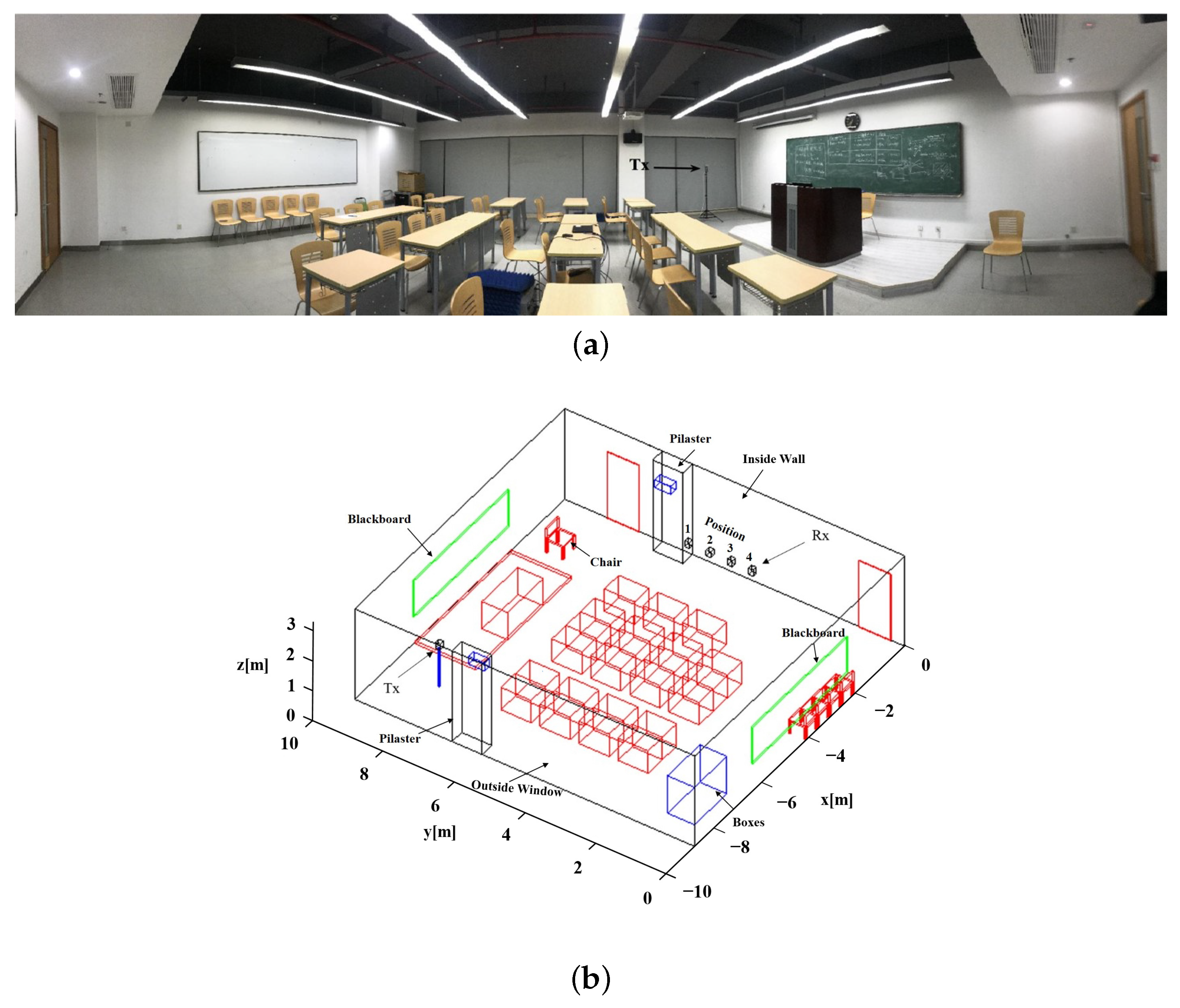
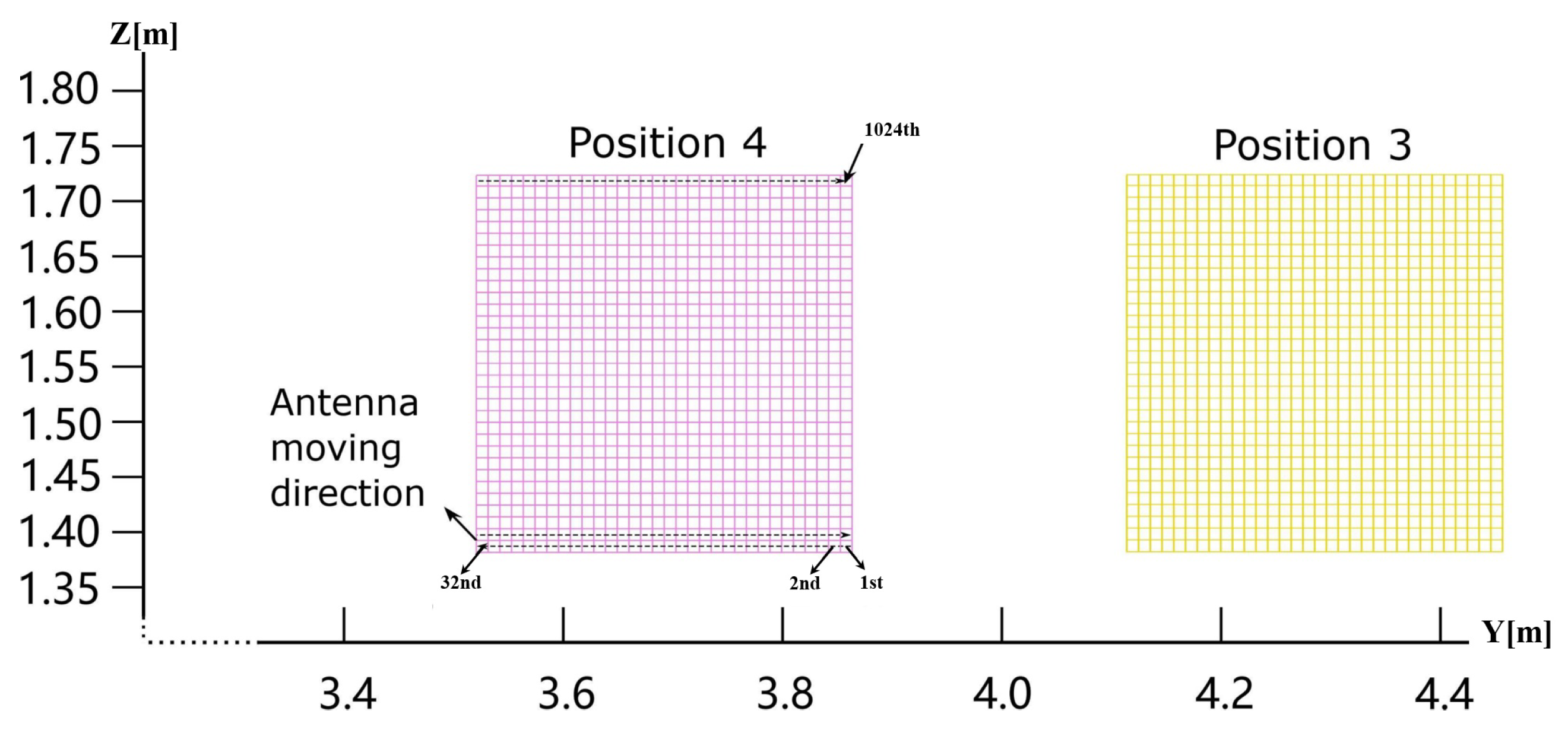



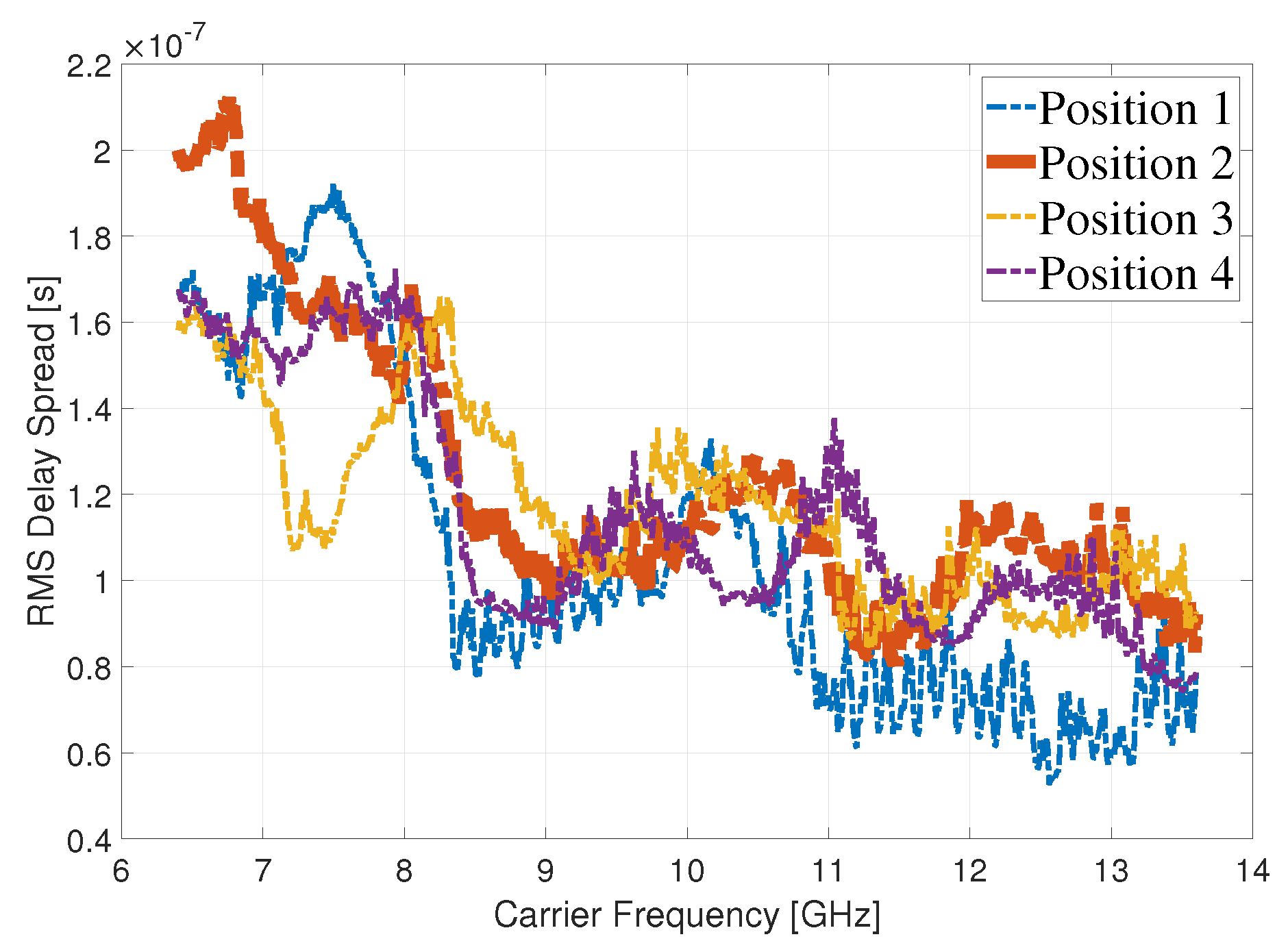


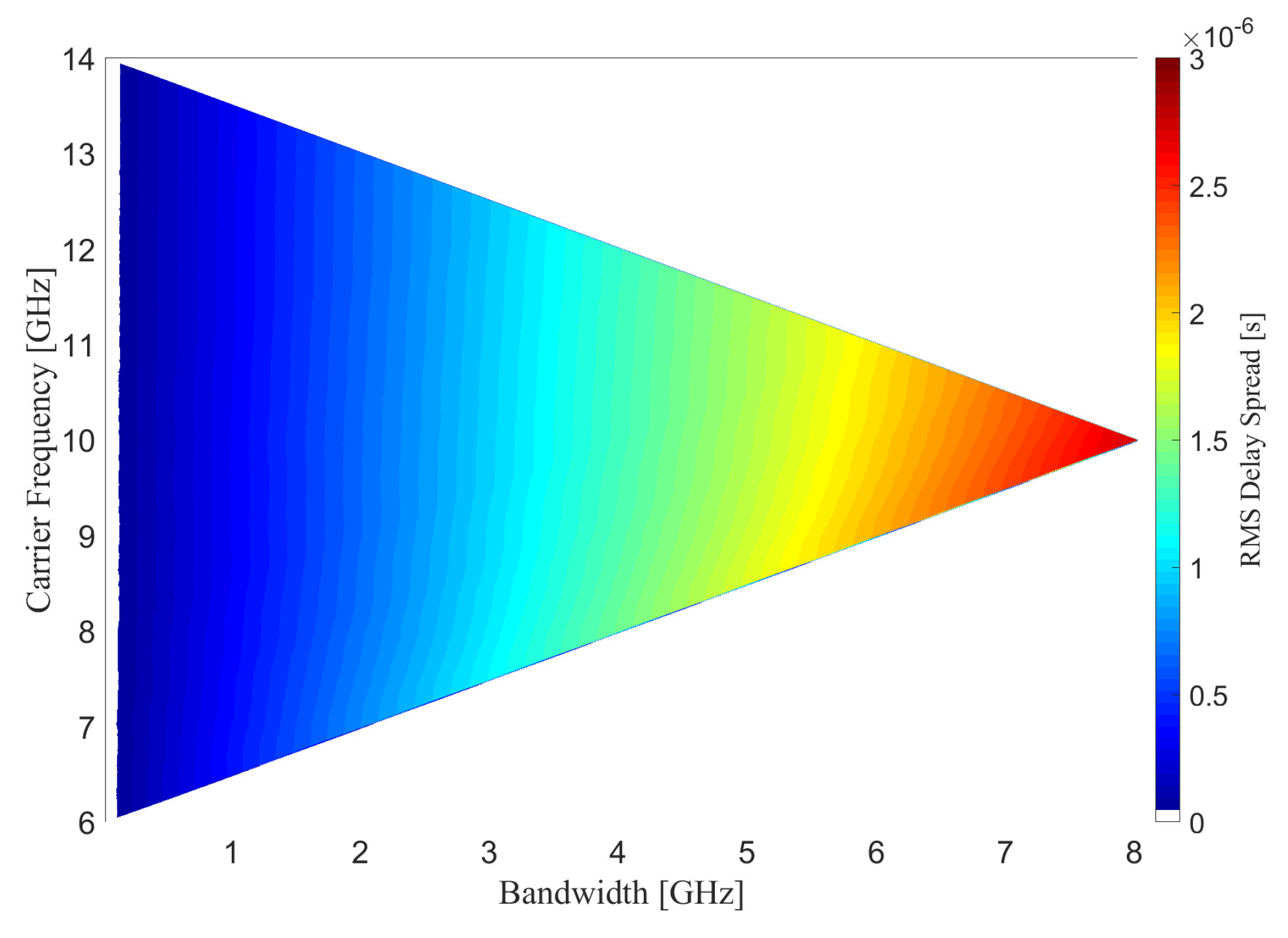
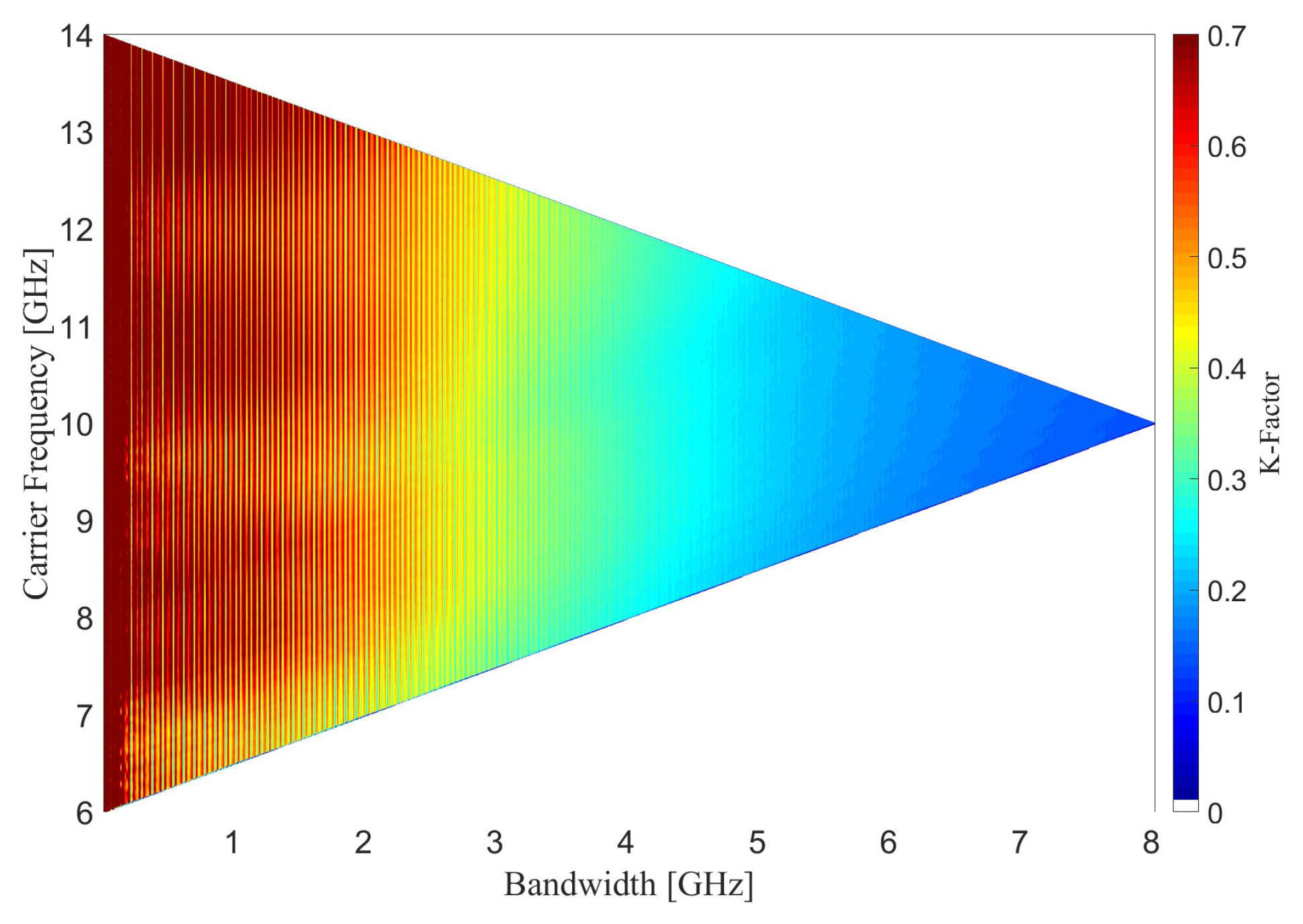
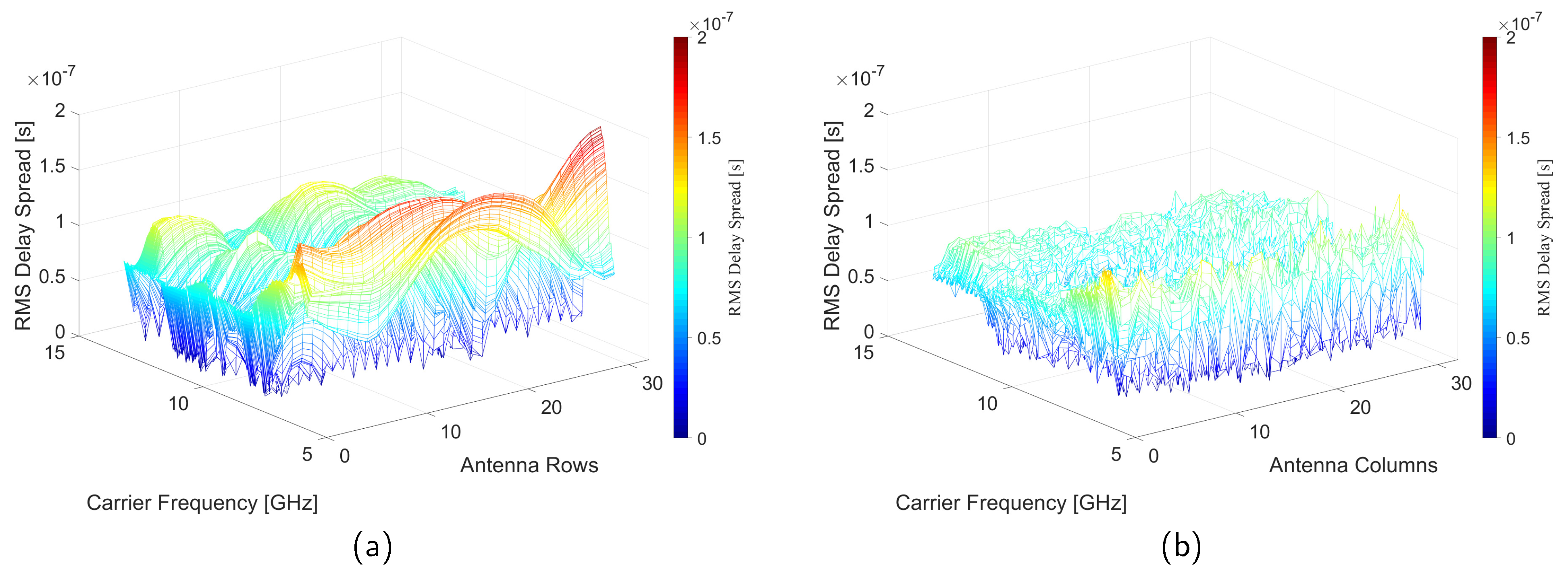




| Parameters | Setup | |
|---|---|---|
| Antenna | Type | Biconical antennas |
| Polarization mode | Vertical polarization | |
| Gain [dB] | 2.4–4.5 | |
| SWR | 2.0:1 | |
| Antenna array | Type | 2D array |
| The space between antenna elements [mm] | ||
| Number of antenna elements | ||
| VNA | Frequency band [GHz] | 6–14 |
| Frequency points | 1001 | |
| Transmitted power [dBm] | 0 |
| Parameter | Coefficient | p-Value |
|---|---|---|
| AR1 | −1.1871 | 3.21 × 10 |
| AR2 | 0.53607 | 2.16 × 10 |
| MA1 | 1.1104 | 7.19 × 10 |
| MA2 | 0.61568 | 5.23 × 10 |
| Carrier Frequency | Bandwidth | Antenna Elements | User Locations | |
|---|---|---|---|---|
| DoF | Decreases monotonically | Increases monotonically | Influenced by antenna aperture size | Influenced by the neighboring environment |
| RMS delay spread | Decreases periodically | Increases monotonically | Changes severely vertically and horizontally | |
| Rician K-Factor | Changes periodically | Decreases monotonically | Changes severely vertically and horizontally |
Publisher’s Note: MDPI stays neutral with regard to jurisdictional claims in published maps and institutional affiliations. |
© 2022 by the authors. Licensee MDPI, Basel, Switzerland. This article is an open access article distributed under the terms and conditions of the Creative Commons Attribution (CC BY) license (https://creativecommons.org/licenses/by/4.0/).
Share and Cite
Wang, Q.; Yin, X.; Hong, J.; Jing, G. Propagation Channel Characterization for 6–14 GHz Bands Based on Large Array Measurement for Indoor Scenarios. Electronics 2022, 11, 3675. https://doi.org/10.3390/electronics11223675
Wang Q, Yin X, Hong J, Jing G. Propagation Channel Characterization for 6–14 GHz Bands Based on Large Array Measurement for Indoor Scenarios. Electronics. 2022; 11(22):3675. https://doi.org/10.3390/electronics11223675
Chicago/Turabian StyleWang, Qi, Xuefeng Yin, Jingxiang Hong, and Guangzheng Jing. 2022. "Propagation Channel Characterization for 6–14 GHz Bands Based on Large Array Measurement for Indoor Scenarios" Electronics 11, no. 22: 3675. https://doi.org/10.3390/electronics11223675





